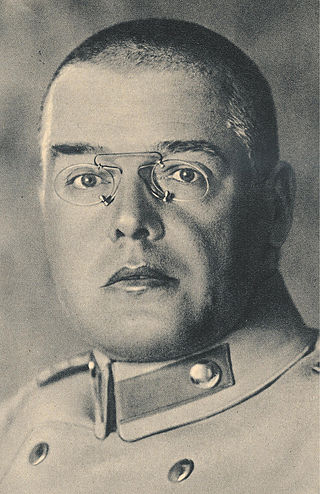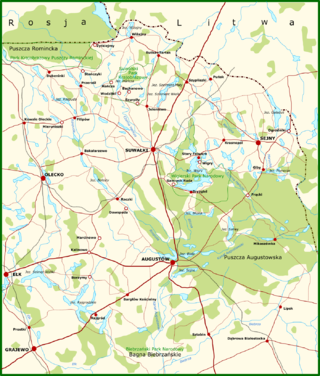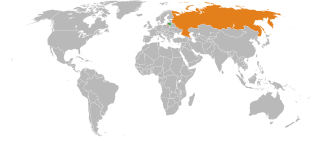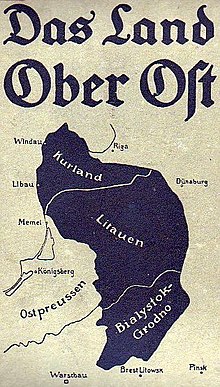
Courland is one of the Historical Latvian Lands in western Latvia. The name probably derives from kur̃t, from kʷer-. The largest city is Liepāja, the third largest city in Latvia. The regions of Semigallia and Selonia are sometimes considered as part of Courland as they were formerly held by the same duke.

The United Baltic Duchy, or alternatively the Grand Duchy of Livonia, was the name proposed during World War I by leaders of the local Baltic German nobility for a new monarchical state that never came into existence. The unsuccessful attempt to establish a new client state of the German Empire on the territory of what is now Latvia and Estonia was made in 1918, during the German occupation of the former Courland, Livonian and Estonian governorates of the Russian Empire which had ceased to exist after the Bolshevik coup in 1917. The unsuccessful proclamation of a pro-German duchy was first made in April 1918, after the Republic of Estonia had already formally declared full independence.

Vilnius County is the largest of the 10 counties of Lithuania, located in the east of the country around the city Vilnius. On 1 July 2010, the county administration was abolished, and since that date, Vilnius County remains as the territorial and statistical unit.

Carl Adolf Maximilian Hoffmann was a German military strategist. As a staff officer at the beginning of World War I, he was Deputy Chief of Staff of the 8th Army, soon promoted Chief of Staff. Hoffmann, along with Hindenburg and Ludendorff, masterminded the devastating defeat of the Russian armies at Tannenberg and the Masurian Lakes. He then held the position of Chief of Staff of the Eastern Front. At the end of 1917, he negotiated with Russia to sign the Treaty of Brest-Litovsk.

Suwałki Region is a small region around the city of Suwałki in northeastern Poland near the border with Lithuania. It encompasses the powiats of Augustów, Suwałki, and Sejny, and roughly corresponds to the southern part of the former Suwałki Governorate. The region was disputed between Poland and Lithuania after their re-emergence as independent states following World War I. This dispute along with the Vilnius question was the cause of the Polish-Lithuanian War and the Sejny Uprising. The area has been subsequently part of Poland until today, with the exception of the German and Soviet occupation during World War II. The Suwałki Region remains as the center of the Lithuanian minority in Poland.

Ober Ost, short for Oberbefehlshaber der gesamten Deutschen Streitkräfte im Osten, was both a high-ranking position in the armed forces of the German Empire as well as the name given to the occupied territories on the German section of the Eastern Front of World War I, with the exception of Poland. It encompassed the former Russian governorates of Courland, Grodno, Vilna, Kovno and Suwałki. It was governed in succession by Paul von Hindenburg and Prince Leopold of Bavaria, and collapsed by the end of World War I.

Ostmark is the name given to a currency denominated in Mark which was issued by Germany in 1918 for use in a part of the eastern areas under German control at that time, the Ober Ost area. The currency consisted of paper money issued on 4 April 1918 by the Darlehnskasse in Kowno (Kaunas) and was equal to the German Papiermark. The Ostmark circulated alongside the Imperial rouble and the Ostrubel, with two Ostmark equal to one Ostrubel.

The Vilna Governorate or Government of Vilnius was a governorate of the Russian Empire created after the Third Partition of the Polish–Lithuanian Commonwealth in 1795. It was part of the Lithuanian General Governorate, which was called the Vilnius General Governorate after 1830, and was attached to the Northwestern Krai. The seat was in Vilnius, where the Governors General resided.

The Grodno Governorate, was a governorate of the Russian Empire. It was part of the Vilna Governorate-General and Northwestern Krai.

The Duchy of Courland and Semigallia was the name for a proposed client state of the German Empire during World War I which did not come into existence. It was proclaimed on 8 March 1918, in the German-occupied Courland Governorate by a council composed of Baltic Germans, who offered the crown of the once-autonomous duchy to Kaiser Wilhelm II, despite the existence of a formerly sovereign reigning family in that duchy, the Biron descendants of Ernst Johann von Biron. Although the German Reichstag supported national self-determination for the peoples of the Baltic provinces, the German High Command continued the policy of attaching these territories to the German Reich by relying on the local Baltic Germans.

This is a survey of the postage stamps and postal history of Lithuania.

Following three consecutive partitions of Poland carried out between 1772 and 1795, the sovereign state known as the Polish–Lithuanian Commonwealth disappeared from the map of Europe. In 1918 following the end of World War I, the territories of the former state re-emerged as the states of Poland and Lithuania among others. In the intervening period, the territory of the former Polish–Lithuanian Commonwealth was split between the Austrian Empire, the Kingdom of Prussia and the Russian Empire. These powers subdivided the territories that they gained and created new toponyms for the territories conquered. The subdivisions created were complicated by changes within those empires as well as by the periodic establishment of other forms of the quasi-Polish provinces led by a foreign head of state.

The Russian Partition, sometimes called Russian Poland, constituted the former territories of the Polish–Lithuanian Commonwealth that were annexed by the Russian Empire in the course of late-18th-century Partitions of Poland. The Russian acquisition encompassed the largest share of Poland's population, living on 463,200 km2 of land constituting the eastern and central territory of the former commonwealth. The three partitions, which took place in 1772, 1793 and 1795, resulted in the complete loss of Poland's sovereignty, with its territory split between Russia, Prussia and Austria. The Napoleonic Wars saw significant parts of Prussia's and Austria's partitions reconstituted as the Duchy of Warsaw, most of which was then reconstituted as the Kingdom of Poland within the Russian Empire in 1815.

Estonia was under military occupation by the German Empire during the later stages of the First World War. On 11–21 October 1917, the Imperial German Army occupied the West Estonian archipelago, including the larger islands of Saaremaa (Ösel), Hiiumaa (Dagö), and Muhu (Moon).

Bialystok-Grodno District was an administrative division of German-controlled territory of Ober-Ost during World War I. It was bordered by the Lithuania District to the north.
The Estonian Provisional Government was formed on 24 February 1918, by the Salvation Committee appointed by Maapäev, the Estonian Province Assembly.

Lithuania–Russia relations are the bilateral foreign relations between Lithuania and Russia. Lithuania has an embassy in Moscow and consulates in Kaliningrad and Sovetsk. Russia has an embassy in Vilnius. In response to 2022 Russian invasion of Ukraine and the Bucha massacre, in April 2022, Lithuania downgraded the diplomatic relations and expelled the Russian ambassador. The two countries share a common border through Kaliningrad Oblast.

The General Government of Warsaw was an administrative civil district created by the German Empire in World War I. It encompassed the north-western half of the former Russian-ruled Congress Poland.
Flugblat was a Yiddish-language daily newspaper published in Vilnius between October 13, 1915 and January, 1916, during the German occupation of the city. Flugblat was the first Yiddish newspaper to appear in Vilnius following the July 1915 Russian ban on non-Cyrillic press. The issues of Flugblat consisted of one or two pages containing translations of official telegram wires from the German military for the Eastern Front and decrees from the German authorities to the local population.

Grobiņas apriņķis was a historic county of the Courland Governorate and shortly of the Republic of Latvia. Its capital was Grobiņa (Grobin).



















